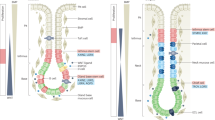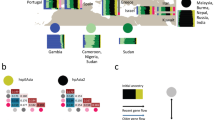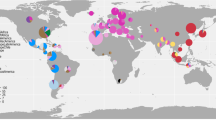Abstract
Since the discovery of the human pathogen Helicobacter pylori, various other Helicobacter species have been identified in the stomach of domesticated and wild mammals. To better understand the evolutionary history of these ecologically similar but genetically distinct species, we analyzed 108 gastric Helicobacter genomes and included 54 enterohepatic Helicobacter genomes for comparison purposes. An admixture analysis supported the presence of an ecological barrier, preventing the genetic exchange between the gastric and enterohepatic Helicobacter species, and unraveled many gene flow events within and across species residing in the stomach. As pets can be colonized by multiple gastric Helicobacter species, the genetic exchange between the canine and feline strains was evident, with H. heilmannii and H. bizzozeronii showing the highest interspecies recombination. An admixture between H. pylori (in particular, the ancestral African strains), H. acinonychis from wild felines and H. cetorum from marine mammals was also identified. Because these latter species do not share the same host, this phenomenon is most likely a remaining signal of shared ancestry. A reconstruction of the time of divergence of the gastric Helicobacter spp. revealed that the domestic animal-related Helicobacter species evolved in parallel with H. pylori and its two closest relatives (H. acinonychis and H. cetorum), rather than together.
Similar content being viewed by others
Log in or create a free account to read this content
Gain free access to this article, as well as selected content from this journal and more on nature.com
or
Change history
28 February 2019
The original version of this Article contained an error in the presentation of the author Armin Ensser, which was incorrectly given as Ensser Armin. The correct author list is as follows:
References
Yang I, Nell S, Suerbaum S. Survival in the hostile territory: the microbiota of the stomach. FEMS Microbiol Rev. 2013;37:736–61.
Solnick JV, Schauer DB. Emergence of diverse Helicobacter species in the pathogenesis of gastric and enterohepatic diseases. Clin Microbiol Rev. 2001;14:59–97.
Mobley HLT, Mendz GL, Hazell SL. Enterohepatic Helicobacter species. Helicobacter pylori: Physiology and Genetics. Washington (DC): ASM Press; 2001. 2001Chapter 43
Moodley Y, Bodo L, Bond RP, Nieuwoudt M, Soodyall H, Schlebusch CM, et al. Age of the association between Helicobacter pylori and man. Plos Path. 2012;8:e1002693.
Schwarz S, Morelli G, Kusecek B, Manica A, Balloux F, Owen RJ, et al. Horizontal versus familial transmission of Helicobacter pylori. Plos Path. 2008;4:e1000180.
Kawai M, Furuta Y, Yahara K, Tsuru T, Oshima K, Handa N, et al. Evolution in an oncogenic bacterial species with extreme genome plasticity: Helicobacter pylori East Asian genome. BMC Microbiol. 2011;11:104.
Suerbaum S, Josenhans C. Helicobacter pylori evolution and phenotypic diversification in a changing host. Nat Rev Microbiol. 2007;5:441–52.
Suerbaum S, Michetti P. Helicobacter pylori infection. New Engl J Med. 2002;347:1175–86.
Kojima KK, Furuta Y, Yahara K, Fukuyo M, Shiwa Y, Nishiumi S, et al. Population evolution of Helicobacter pylori through diversification in DNA methylation and interstrain sequence homogenization. Mol Biol Evol. 2016;33:2848–59.
Maixner F, Krause-Kyora B, Turaev D, Herbig A, Hoopmann MR, Hallows JL, et al. The 5300-year-old Helicobacter pylori genome of the Iceman. Science. 2016;351:162–5.
Yahara K, Furuta Y, Oshima K, Yoshida M, Azuma T, Hattori M, et al. Chromosome painting in silico in a bacterial species reveals fine population structure. Mol Biol Evol. 2013;30:1454–64.
Eppinger M, Baar C, Linz B, Raddatz G, Lanz C, Keller H, et al. Who ate whom? Addaptive Helicobacter genomic changes that accompanied a host jump from early humans to large felines. Plos Genet. 2006;2:e120.
Kersulyte D, Rossi M, Douglas B. Sequence divergence and conservation in genomes of Helicobacter cetorum strains from a dolphin and a whale. Plos One. 2013;8:e83177.
Haesebrouck F, Pasmans F, Flahou B, Chiers K, Baele M, Meyn T, et al. Gastric helicobacters in domestic animals and non-human primates and their significance for human health. Clin Microbiol Rev. 2009;22:202–23.
Dewhirst FE, Shen Z, Scimeca MS, Stokes LN, Boumenna T, Chen T, et al. Discordant 16S and 23S rRNA gene phylogenies for the genus Helicobacter: implications for phylogenetic inference and systematics. J Bacteriol. 2005;187:6106–18.
Joosten M, Linden S, Rossi M, Tay ACY, Skoog E, Medea P, et al. Divergence between the highly virulent Helicobacter heilmannii and its closest relative, the low-virulence Helicobacter ailurogastricus sp. nov. Infect Immun. 2015;84:293–306.
Flahou B, Haesebrouck F, Smet A. (2016). Non-Helicobacter pylori Helicobacter infections in humans and animals. Helicobacter pylori Res. 233–73.
Gueneau P, De Goër SL. Helicobacter: molecular phylogeny and the origin of gastric colonization in the genus. Infect Gen Evol. 2002;1:215–33.
Arnold AC, Zigova Z, Holden M, Lawley TD, Rad R, Dougan G, et al. Comparative whole genome sequence analysis of the carcinogenic bacterial model pathogen Helicobacter felis. Genome Biol Evol. 2011;3:302–8.
O’Toole PW, Snelling WJ, Canchaya C, Forde BM, Hardie KR, Josenhans C, et al. Comparative genomics and proteomics of Helicobacter mustelae, an ulcerogenic and carcinogenic gastric pathogen. BMC Genomics. 2010;11:164.
Schott T, Kondadi PK, Hänninen ML, Rossi M. Comparative genomics of Helicobacter pylori and the human-derived Helicobacter bizzozeronii CIII-1 strain reveal the molecular basis of thezoonotic nature of non-pylori gastric Helicobacter infections in humans. BMC Genomics. 2011;12:534.
Smet A, Van Nieuwerburgh F, Ledesma J, Flahou B, Deforce D, Ducatelle R, et al. Genome sequence of Helicobacter heilmannii sensu stricto ASB1 isolated from the gastric mucosa of a kitten with severe gastritis. Genome Announce. 2013;1:e00033–12.
Vermoote M, Vandekerckhove TT, Flahou B, Pasmans F, Smet A, De Groote D, et al. Genome sequence of Helicobacter suis supports its role in gastric pathology. Vet Res. 2011;42:51.
Fox JG, Correa P, Taylor NS, Lee A, Otto G, Murphy JC, et al. Helicobacter mustelae-associated gastritis in ferrets: an animal model of Helicobacter pylori gastritis in humans. Gastroenterology. 1990;99:352–61.
Fox JG, Marin RP. Helicobacter mustelae infection in ferrets: pathogenesis, epizootiology, diagnosis and treatment. Sem Avian Exot Pet Med. 2001;10:36–44.
Seemann T. Prokka: rapid prokaryotic genome annotation. Bioinformatics. 2014;30:2068–9.
Page AJ, Cummins CA, Hunt M, Wong VK, Reuter S, Holden MT, et al. Roary: rapid large-scale prokaryote pan genome analysis. Bioinformatics. 2015;31:3691–3.
Brynildsrud O, Bohlin J, Scheffer L, Eldholm V. Rapid scoring of genes in microbial pan-genome-wide association studies with Scoary. Genome Biol. 2016;17:238.
Remmert M, Biegert A, Hauser A, Söding J. HHblits: lightning-fast iterative protein sequence searching by HMM-HMM alignment. Nat Met. 2012;9:173–5.
Zimmerman L, Stephens A, Nam SZ, Rau D, Kübler J, Lozajic M et al. (2017). A completely reimplemented MPI bioinformatics toolkit with a new HHpred server at its core. J Mol Biol. https://doi.org/10.1016/j.jmb.2017.12.007.
Stamatakis A. RAxML version 8: a tool for phylogenetic analysis and post-analysis of large phylogenies. Bioinformatics. 2014;30:1312–3.
Letunic I, Bork P. Interactive tree of life (iTOL) v3: an online tool for the display and annotation of phylogenetic and other trees. Nucl Acids Res. 2016;44:W242–245.
Cheng L, Connor TR, Siren J, Aanensen DM, Corrander J. Hierarchical and spatially explicit clustering of DNA sequences with BAPS software. Mol Biol Evol. 2013;30:1224–8.
Sandeep JJ, Cox D, Wilff B, Morisson SS, Kozal-Muiznieks NA, Frace M, et al. Dynamics of genome change among Legionella species. Sci Rep. 2016;6:33442.
Corander J, Marttinen P. Bayesian identification of admixture events using multilocus molecular markers. Mol Ecol. 2006;15:2833–43.
Corander J, Marttinen P, Siren J, Tang J. Enhanced Bayesian modelling in BAPS software for learning genetic structures of populations. BMC Bioinform. 2008;9:539.
To TH, Jung M, Lycette S, Gascuel O. Fast dating using least-squares criteria and algorithms. Syst Biol. 2015;00:1–16.
Rambaut A, Lam TT, Carvalho LM, Pybus OG. Exploring the temporal structure of heterochronous sequences using TempEst (formerly Path-O-Gen). Virus Evol. 2016;2:vew007.
Darch ES, McNally A, Harrison F, Corander J, Barr HL, Paszkiewicz, et al. Recombination is a key driver of genomic and phenotypic diversity in a Pseudomonas aeruginosa population during cystic fibrosis infection. Sci Rep. 2015;5:7649.
Kennemann L, Didelot X, Aebischer T, Kuhn S, Dresher B, Droege M, et al. Helicobacter pylori genome evolution during human infection. Proc Natl Acad Sci USA. 2011;108:5033–8.
Fraser C, Hanage WP, Spratt BG. Recombination and the nature of bacterial speciation. Science. 2007;315:476–80.
Walter J. Ecological role of Lactobacilli in the gastrointestinal tract: implications for fundamental and biomedical research. Appl Environ Microbiol. 2008;74:4985–96.
Klemm E, Dougan R. Advances in understanding bacterial pathogenesis gained from whole genome sequencing and phylogenetics. Cell Host Microbe. 2016;19:599–610.
Sheppard SK, Didelot X, Meric G, Torralbo A, Jolley KA, Kelly DJ, et al. Genome-wide association study identifies vitamin B5 biosynthesis as a host specificity factor in Campylobacter. Proc Natl Acad Sci USA. 2013;29:11923–7.
Lees JA, VehKala M, Valimaki N, Harris SR, Chewapreecha C, Croucher NJ, et al. Sequence element enrichment analysis to determine the genetic basis of bacterial phenotypes. Nat Commun. 2016;7:12797.
Vinella D, Fischer F, Vorontsov E, Gallaud J, Malosse C, Michel V, Cavazza C, Robbe-Saule M, Richaud P, Chamot-Rooke J, Brochier-Armanet C, De Reuse H. Evolution of Helicobacter: acquisition by gastric species of two histidine-rich proteins essential for colonization. Plos Path. 2015;11:e10053.
Fischer F, Robbe-Saule M, Turlin E, Mancuso F, Michel V, Richaud P, et al. Characterization in Helicobacter pylori of a nickel transporter essential for colonization that was acquired during evolution by gastric Helicobacter species. Plos Path. 2016;12:e1006018.
Weinberg MV, Maier RJ. Peptide transport in Helicobacter pylori: roles of Dpp and Opp systems and evidence for additional peptide transporters. J Bacteriol. 2007;189:3392–402.
Oleastro M, Ménard A. The role of Helicobacter pylori outer membrane proteins in adherence and pathogenesis. Biology. 2013;2:1110–34.
Cynober L. Can arginine and ornithine support gut functions? Gut. 1994;35:S42–S45.
Baele M, Decostere A, Vandamme P, Ceelen L, Hellemans A, Mast J, et al. Isolation and characterization of Helicobacter suis sp. nov. from pig stomachs. Int J Syst Evol Microbiol. 2008;58:1350–8.
Green RE, Krause J, Ptak SE, Briggs AW, Ronan MT, Simons JF, et al. Analysis of one million base pairs of Neanderthal DNA. Nature. 2006;444:330–6.
Nikaido M, Matsuno F, Hamilton H, Brownell RL, Cao Y, Ding W, et al. Retroposon analysis of major cetacean lineages: the monophyly of toothed whales and the paraphyly of river dolphins. Proc Natl Acad Sci USA. 2001;98:7384–9.
Smith EM, Needs PF, Manley G, Green LE. Global distribution and diversity of ovine-associated Staphylococcus aureus. Infect Genet Evol. 2014;22:208–15.
Flahou B, Rossi M, Bakker J, Langermans J, Heuvelman E, Solnick J, et al. Evidence for a primate origin of zoonotic Helicobacter suis colonizing domesticated pigs. ISME. 2017. https://doi.org/10.1038/ismej.2017.145
O’Brien SJ, Johnson W, Driscoll C, Pontius J, Pecon-Slattery J, Menotti-Raymond M. State of cat genomics. Trends Genet. 2008;24:268–79.
Wayne RK, Ostrander EA. Lessons learned from the dog genome. Trends Genet. 2007;23:557–67.
De Witte C, Devriendt B, Flahou B, Bosschem I, Ducatelle R, Smet A, et al. Helicobacter suis induces changes in gastric inflammation and acid secretion markers in pigs of different ages. Vet Res. 2017;48:34.
Hadfield J, Croucher NJ, Goater RJ, Abudahab K, Aanensen DM, Harris SR. Phandango: an interactive viewer for bacterial population genomics. Bioinformatics. 2017. https://doi.org/10.1093/bioinformatics/btx610
Acknowledgements
We thank Sofie Debruyckere and Nathalie Van Rysselberghe for their skilled technical assistance. This work was supported by the Research Fund of Ghent University (01G00408), by the Research Foundation Flanders (FWO Vlaanderen, 1220217N), by the Research Fund of Antwerp University (34871) and by “Grant-in-Aid for Scientific Research” from MEXT (15K21554 to KY). The work of SB was supported by a grant of the German Science Foundation (project A04 in CRC-1181). We thank Editage (www.editage.jp) for English language editing. Computational calculations were performed at the Human Genome Center, at the Institute of Medical Science (the University of Tokyo).
Author information
Authors and Affiliations
Corresponding authors
Ethics declarations
Conflict of interest
The authors declare that they have no conflict of interest.
Rights and permissions
About this article
Cite this article
Smet, A., Yahara, K., Rossi, M. et al. Macroevolution of gastric Helicobacter species unveils interspecies admixture and time of divergence. ISME J 12, 2518–2531 (2018). https://doi.org/10.1038/s41396-018-0199-5
Received:
Revised:
Accepted:
Published:
Issue date:
DOI: https://doi.org/10.1038/s41396-018-0199-5
This article is cited by
-
Systematic review on the zoonotic potential of Helicobacter pylori
Discover Public Health (2025)
-
An ancient ecospecies of Helicobacter pylori
Nature (2024)
-
Presence of potentially novel Helicobacter pylori-like organisms in gastric samples from cats and dogs
Veterinary Research (2023)
-
Gastric Helicobacter species associated with dogs, cats and pigs: significance for public and animal health
Veterinary Research (2022)
-
Comparative genomics analysis to differentiate metabolic and virulence gene potential in gastric versus enterohepatic Helicobacter species
BMC Genomics (2018)



